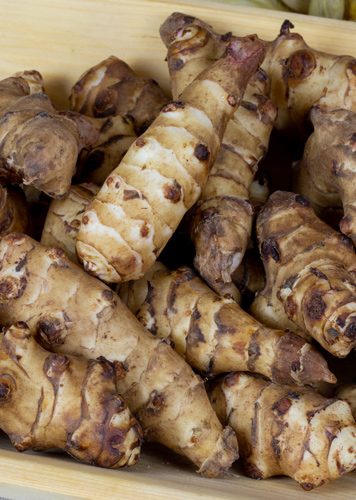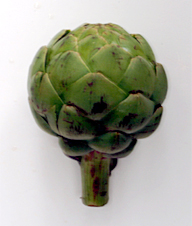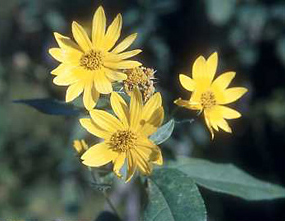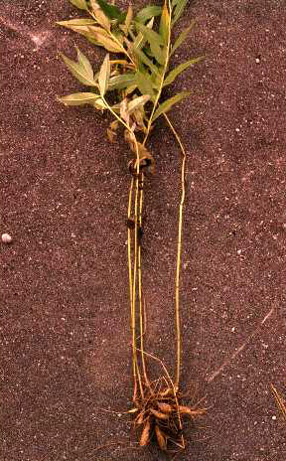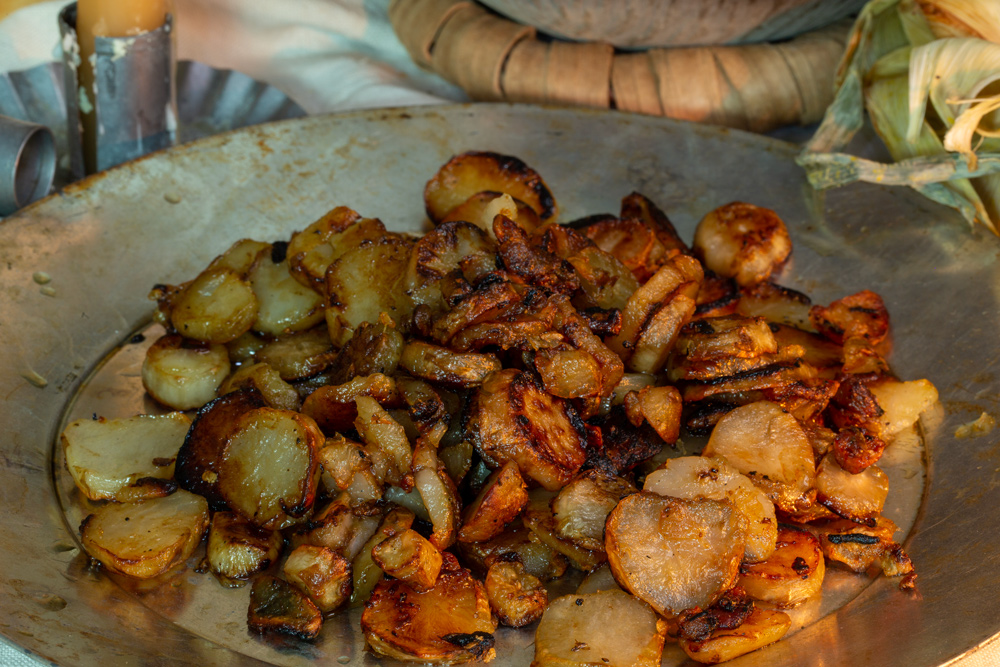Cultivated Jerusalem Artichokes
Helianthus tuberosus
© 2020 by Kristopher K. Townsend. Permission to use granted under the Creative Commons Attribution-Share Alike 4.0 International license.
When describing Indian root vegetables, Lewis often compared them—most notably the western spring beauty—with the Jerusalem artichoke. It is likely that they came across the actual plant on at least two occasions. While at Fort Mandan, Lewis remarked that the Hidatsas “have plenty of artichokes.” Clark’s remark further explained that the root was both wild and cultivated:
The Indians raise a kind of artechokes which they Say is common in the praries. well tasted.[1]Weather Diary Remarks for 20 March 1806 (Lewis) and undated (Clark).
For dinner, soon after the expedition left Fort Mandan, Sacagawea gathered the tuber, apparently by raiding the caches made by the bean mouse, or meadow mouse[2]Clay S. Jenkinson, A Vast and Open Plain: The Writings of the Lewis and Clark Expedition in North Dakota, 1804–1806 (Bismarck, North Dakota: State Historical Society of North Dakota, 2003), … Continue reading. On 9 April 1805, Lewis described the plant:
when we halted for dinner the squaw busied herself in serching for the wild artichokes which the mice collect and deposit in larger hoards. this operation she performed by penetrating the earth with a sharp stick about some small collections of drift wood. her labour soon proved successful, and she procurrd a good quantity of these roots. the flavor of this root resembles that of the Jerusalem Artichoke, and the stalk of the weed which produces it is also similar, tho’ both the root and stalk are much smaller than the Jarusalem Artichoke. the root is white and of an ovate form, from one to three inches in length and usually about the size of a man’s finger. one stalk produces from two to four, and somitimes six of these roots.—
Mistaken Identity
The Jerusalem artichoke, and none of the plants Lewis compared it with, has any resemblance whatsoever to the now-familiar globe artichoke, Cynara scolymus (SIN-uh-ruh, Greek for “dog’s teeth”; SKOL-ee-mus, “pointed”).
The globe artichoke is a member of the thistle branch of the Aster or Daisy family, Asteraceae (ass-ter-AY-see-ee). A native of the Mediterannean coast of North Africa with a long history both as a food and a medicine, the globe artichoke became popular among aristocrats in England and France during the sixteenth century, and was highly regarded among men as an aphrodisiac. The edible part of the plant is its immature flower, which lends the whole plant its common name. It was still essentially unknown in America as a food until after the turn of the 19th century, but is now a familiar item in supermarket vegetable bins, and is still respected for its healthful values. In the U.S. it is cultivated for commercial purposes chiefly near the coast of central California. The word artichoke possibly came from an Arabic word, al-harsuf, which was transformed into the Spanish word alcachofa in the Middle Ages, during the Muslim occupation of Western Europe.
The Jerusalem artichoke differs from the globe artichoke in every detail, with nothing in common but an etymologically misleading name. Noah Webster, in his Compendious Dictionary of the English Language (1806), defined artichoke as “a garden vegetable, a sunflower.” He did not include any place-names, so it is not listed under Jerusalem. The latter word, as applied to this vegetable, may be an English corruption (mistranslation-plus-mispronunciation) of the Italian name for sunflower, girasole (jeer-uh-SOH-le). The “Jerusalem artichoke” is also known as a “sunchoke,” clearly a union of the first syllable of sunflower with the second of artichoke. It is also known as sunroot and earth apple.[3]“Jerusalem Artichoke,” Wikipedia, last modified 10 October 2020, https://en.wikipedia.org/wiki/Jerusalem_artichoke.The scientific name for the Jerusalem artichoke is Helianthus tuberosus (hel-ee-AN-thus, too-ber-OH-sus), Latin for “sunflower with a lumpy root.” It is a member of the Sunflower branch of the family Asteraceae.
Growing
The French explorer Samuel de Champlain (1567–1635) found the vegetable growing in Indian gardens along the Saint Lawrence seaway and carried specimens of it back to France in 1603, where its root soon became a staple food for humans, and the rest of it fodder for their livestock. By the late eighteenth century it became a popular vegetable in both Europe and America, though it yielded to the larger potato during the first half of the nineteenth century. Today the sunchoke is found only seasonally among specialty vegetables in markets because it dries out so quickly after it is dug up. The Jerusalem artichoke is easy to tend when grown in an orderly garden, but if one is left in the ground unattended for more than one season it multiplies on its own, and its offspring promptly hit the road to make weeds of themselves.
Cooking
Fried Jerusalem Artichokes
Helianthus tuberosus
© 2020 by Kristopher K. Townsend. Permission to use granted under the Creative Commons Attribution-Share Alike 4.0 International license.
As a root vegetable, the Jerusalem artichoke cooks much like a potato—but with some key differences. First, they quickly become soft and overcooked. Second, they can be eaten raw. When sliced thin and added to salads, they are similar to water chestnuts. In raw form, they possess a significant quantity of inulin, a large sugar that can produce considerable intestinal gas and bloating. As with raw camas and other Indian root vegetables, eating too much inulin could recreate one of the expedition’s more uncomfortable moments:
Capt Lewis & my Self eate a Supper of roots boiled, which filled us So full of wind, that we were Scercely able to Breathe all night felt the effects of it.
—William Clark, Clearwater Canoe Camp, 5 October 1805
For these reasons, the Jerusalem artichoke is best steamed or fried. Prior to cooking, scrub, rinse, and then pare off most of the skin and nodules.
Nutritional Value
Today, the Jerusalem Artichoke is somewhat larger than the root described by Lewis. The U.S. Department of Agriculture provides the following nutritional information for a 1 cup (150 gram) serving.[4]“Artichoke, Jerusalem, raw,” U.S. Department of Agriculture, last updated 1 April 2020, https://ndb.nal.usda.gov/fdc-app.html#/food-details/787773/nutrients and “RDA: Dietary … Continue reading
| Name | Amount | Unit | RDA | % RDA |
|---|---|---|---|---|
| Water | 117 | g | ||
| Energy | 110 | kcal | ||
| Total lipid (fat) | 0.015 | g | ||
| Sugars, total including NLEA | 14.4 | g | ||
| Iron, Fe | 5.1 | mg | 8 | 63.8% |
| Thiamin | 0.3 | mg | 1.2 | 25.0% |
| Carbohydrate, by difference | 26.2 | g | 130 | 20.2% |
| Phosphorus, P | 117 | mg | 700 | 16.7% |
| Potassium, K | 644 | mg | 4700 | 13.7% |
| Niacin | 1.95 | mg | 16 | 12.2% |
| Vitamin B-6 | 0.116 | mg | 1.3 | 8.9% |
| Choline, total | 45 | mg | 550 | 8.2% |
| Fiber, total dietary | 2.4 | g | 33.6 | 7.1% |
| Riboflavin | 0.09 | mg | 1.3 | 6.9% |
| Vitamin C, total ascorbic acid | 6 | mg | 90 | 6.7% |
| Magnesium, Mg | 25.5 | mg | 400 | 6.4% |
| Protein | 3 | g | 56 | 5.4% |
| Folate, total | 19.5 | µg | 400 | 4.9% |
| Calcium, Ca | 21 | mg | 1000 | 2.1% |
| Selenium, Se | 1.05 | µg | 55 | 1.9% |
| Vitamin E (alpha-tocopherol) | 0.285 | mg | 15 | 1.9% |
| Zinc, Zn | 0.18 | mg | 11 | 1.6% |
| Sodium, Na | 6 | mg | 2300 | 0.3% |
| Vitamin A, RAE | 1.5 | µg | 900 | 0.2% |
| Vitamin K (phylloquinone) | 0.15 | µg | 120 | 0.1% |
| Copper, Cu | 0.21 | mg | 900 | 0.0% |
| Vitamin D (D2 + D3) | 0 | µg | 15 | 0.0% |
Notes
| ↑1 | Weather Diary Remarks for 20 March 1806 (Lewis) and undated (Clark). |
|---|---|
| ↑2 | Clay S. Jenkinson, A Vast and Open Plain: The Writings of the Lewis and Clark Expedition in North Dakota, 1804–1806 (Bismarck, North Dakota: State Historical Society of North Dakota, 2003), 284n355, n366. |
| ↑3 | “Jerusalem Artichoke,” Wikipedia, last modified 10 October 2020, https://en.wikipedia.org/wiki/Jerusalem_artichoke. |
| ↑4 | “Artichoke, Jerusalem, raw,” U.S. Department of Agriculture, last updated 1 April 2020, https://ndb.nal.usda.gov/fdc-app.html#/food-details/787773/nutrients and “RDA: Dietary Guidelines 2015–2020, Appendix 7. Nutritional Goals for Age-Sex Groups Based on Dietary Reference Intakes and Dietary Guidelines Recommendations, Table A7-1.” U. S, Department of Agriculture, https://health.gov/our-work/food-nutrition/2015-2020-dietary-guidelines/guidelines/appendix-7/#table-a7-1-daily-nutritional-goals-for-age-sex-groups-based-on-d. |
